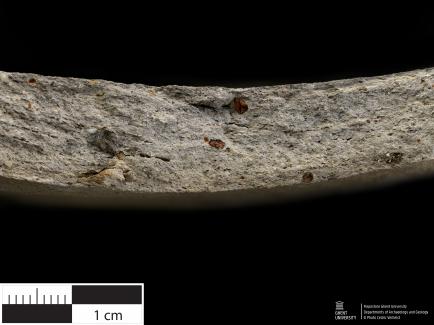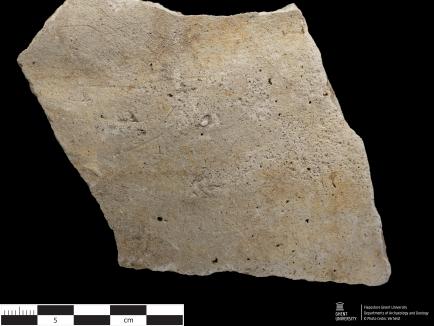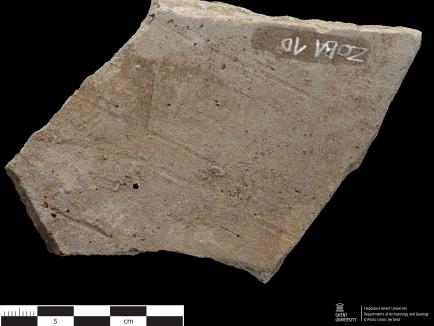Medieval - Grey reduced ware (6.GR.BE.0004)
Hand specimen pictures (macro & binocular)
Thin section pictures
Find location
- Category
- Grey reduced ware (Medieval)
- Fabric name
- Chronology
- Medieval > High Medieval > 12th century
- Dating method(-s)
- morphology
- Potters' mark
- No
- Additional information
- pottery production consists of globular pots, spout pots and frying pans; based on the various rim types of the globular pots the production is probably situated in the middle of the 12th century
Find location
- Site type
- Pottery production
- Location
- Belgium; Oost-Vlaanderen; Lievegem
- Site name
- Zomergem, Bauwerwaan
- Excavation or Survey Team
- W. De Clercq, K. De Groote, J. Moens & S. Mortier (Provincie Oost-Vlaanderen en Instituut voor het Archeologisch Patrimonium)
- Additional contextual information
- pottery production wasters dump, clay extraction structure (feature 1), ZOBA 1D
- Slip
- No
- Slip color
- Glaze
- No
- Glaze type
- Glaze color
- Glaze additives
- Additional information
- Slip
- No
- Slip color
- Glaze
- No
- Glaze type
- Glaze color
- Glaze additives
- Additional information
- Surface color
- light grey
- Surface texture
- Rough
- Fracture color
- light grey
- Inclusions (non-plastics/tempering)
- medium to fine grained quartz, some larger ('milk white') quartz granules appear (up to 2 mm and more), large rounded brown and grey inclusions (clay pellets ? )
- Matrix and voids
- /
- Diagnostic features
- Additional information
- ZOBA ST2
- Flepostore inventory nr.
- ARCH1.L1.B8
- Original inventory nr.
- A0024
- Collection
- Archaeological Department, Ghent University
- Type
- Covered thin section
- Comparable thin section(s)
- Matrix
-
Reduced light grey fabric with dark grey edges; dark brown (PPL), black (XP).
Semi-heterogeneous matrix, non-calcareous with no optical activity.
- ca. 40-55% - Inclusions
-
Quartz (++; mono, poly, cf: r-sr, fine to medium sand + coarse sand outlier, ff: sr-sa, very fine to fine sand), sedimentary rock detritus (+-; possible quartz arenite, some slightly metamorf), chert/flint (+-), feldspars (+-; plagioclase, microcline, r, cf), muscovite mica (+-; cf & ff, el), O/Fe (+), semiplastics/clay pellets (+, iron-rich).
The coarse fraction consists of fine to medium/coarse sand, the fine fraction consists of fine to very fine sand. Grains are generally rounded to subangular. Overall the fabric is poorly to very poorly sorted and moderately to poorly orientated, single to double spaced.
- ca. 30-40% - Voids
-
Many planar voids, channels and vughs of various sizes, moderate alignment relative to the edge. Zones and layers of diffuse secondary calcite: micritic calcite crystals deposited through voids forming layers and patches.
- ca. 15-20% - Diagnostic features
- The fabric is characterized by a semi-heterogeneous reduced matrix with no optical activity and high porosity. Dominant quartz inclusions with frequent opaques/iron oxides and semiplastics/clay pellets, common sedimentary rock detritus, chert/flint, feldspars and muscovite mica. Overall poorly to very poorly sorted fabric.
- Additional information
- Clay type
- glauconite-rich clay
- Chronostratigraphy
- Phanerozoic; Cenozoic; Paleogene; Eocene
- Lithostratigraphy
- Maldegem Formation; Wemmel Member
- Additional information
- often referred to as "Tertiary clay"
- Sample type
- Pottery
- Inventory number
- 6.GR.BE.0004
- Collection
- Archaeological Department, Ghent University
- Donating institute/person
- Archeodepot, Archeocentrum Velzeke
- Host collection
- Archeodepot, Archeocentrum Velzeke
- Other samples available
- No
- Sample collection method
- Archaeological Excavation
De Clercq et al. 2001b
- Full reference
-
De Clercq W., De Groote K., Moens J. & Mortier S. 2001. Zomergem. Bauwerwaan: sporen van 12de-eeuwse kleiwinning en pottenbakkersactiviteit. Monumentenzorg en Cultuurpatrimonium. Jaarverslag van de Provincie Oost-Vlaanderen 2000: 192-195.
Cite this page as: Flepostore - https://flepostore.ugent.be/ceramics/6-gr-be-0004
Last modified: 2024-04-28.





